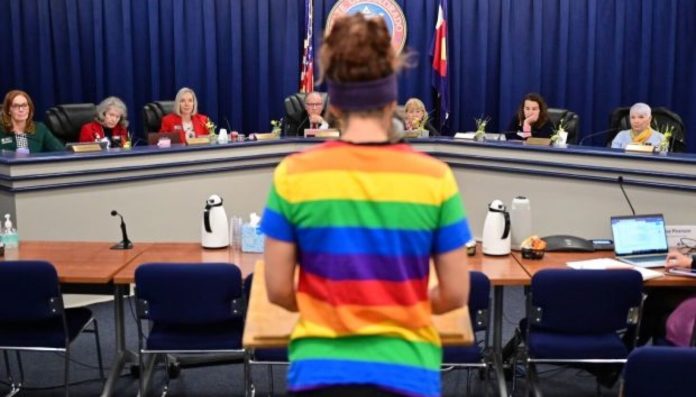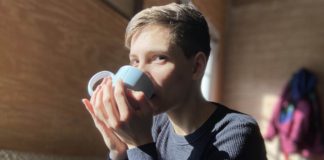Fewer than half of transgender, nonbinary, gay, lesbian, and bisexual Colorado youth said they feel like they belong at their school, according to a biennial health survey. More than a quarter of transgender youth who took the survey reported attempting suicide in the previous year.
Those are some of the alarming findings of the Healthy Kids Colorado survey, which is administered every two years. Local LGBTQ+ educators and advocacy organizations said it’s important that schools, teachers, parents, and lawmakers pay attention.
“As dark as this data is, we have an ability to make a change,” said Joyce Giuhat, a queer educator who teaches middle and high school math at a charter school in Federal Heights.
“It would be almost inhuman to not have some sort of reaction to youth that are actively making plans to commit suicide or not showing up to school because they don’t feel safe,” said Libby Goertz, the director of an early childhood education center in Denver. Goertz, who is a lesbian, co-hosts a podcast with Giuhat called Lesbi-Educated: Teaching Out of the Closet.
“People have to see it to feel some sort of push to make change,” Goertz said.
In the fall of 2021, 106,799 students at 340 public middle and high schools across the state took the Healthy Kids Colorado survey administered by researchers at the University of Colorado Anschutz Medical Campus. The results, which are meant to provide a snapshot of what Colorado youth are experiencing, were released last week.
The anonymous survey asks students about their mental health, drug and alcohol use, and sexual activity. It also asks about bullying, safety, and whether they’ve experienced racism. The 2021 survey included more expansive response options for questions about race and ethnicity, sexual orientation, and gender identity. That allowed researchers to parse the data in more detailed ways, providing a clearer picture of the health of different groups of students.
“Importantly, the survey points to the need to support and increase protective factors for youth of color and LGBTQ+ youth,” Jill Hunsaker Ryan, the executive director of the Colorado Department of Public Health and Environment, said in a statement.
Findings from the survey include:
A higher percentage of LGBTQ+ youth reported attempting suicide. For example, 26% of transgender youth who took the survey reported attempting suicide one or more times in the previous 12 months, while 7% of cisgender youth did. Twenty percent of bisexual and 18% of gay or lesbian youth reported attempting suicide compared to 4% of straight youth.
LGBTQ+ youth were more likely to report being bullied at school. Twenty-eight percent of transgender youth reported having been bullied on school property in the previous 12 months, while 10% of cisgender youth did. Twenty percent of bisexual and 18% of gay or lesbian youth reported having been bullied at school compared to 9% of straight youth.
Students of color were more likely to report being treated badly or unfairly at school because of their race. Sixteen percent of Black, East or Southeast Asian, and Middle Eastern youth reported being treated badly or unfairly at school because of their race or ethnicity in the previous 12 months. Thirteen percent of South Asian, 10% of multi-racial, and 8% of Hispanic or Latinx youth reported the same. Just 2% of white youth did.
Fewer LGBTQ+ youth said they belong at their school. Sixty-six percent of cisgender youth reported feeling like they belong at their school, while 38% of transgender youth did. Seventy-one percent of straight youth reported feeling that way, compared to 49% of bisexual and 48% of gay or lesbian youth.
Students of color and LGBTQ+ youth were more likely to experience hunger at home during the COVID-19 pandemic. Eighteen percent of Indigenous youth, 13% of Black youth, and 10% of Hispanic or Latinx youth reported going hungry sometimes, most of the time, or always because there was not enough food at home during the pandemic. Six percent of white students reported the same. Thirteen percent of gay or lesbian youth and 10% of bisexual youth reported going hungry at home during the pandemic, compared to 7% of straight youth.
LGBTQ+ youth were less likely to have an adult they can go to for help with a serious problem. Fifty-seven percent of transgender youth reported having such an adult, while 74% of cisgender youth did. Sixty-three percent of gay or lesbian and 65% of bisexual youth did versus 77% of straight youth.
Math teacher Giuhat, who uses she/they pronouns, said many LGBTQ+ students at their school view their classroom as a safe space. Giuhat has a Pride flag in their classroom and wears her work badge on a rainbow lanyard. They introduce themselves using their pronouns and encourage students to do the same. Giuhat asks students which name they prefer to be called. If they hear students using derogatory words, they address it right away.
Inclusive practices such as those go a long way, she said.
“When a kid loves coming to my class — kids will say, ‘You have a Pride flag! You get me!’ — they’re 10 times more open to learning,” Giuhat said.
With discriminatory efforts underway across the nation to ban schools from teaching lessons about sexual orientation and gender identity, this moment is incredibly tender for LGBTQ+ youth, said statewide LGBTQ+ advocacy group One Colorado. Here in Colorado, a committee tasked with reviewing the guidelines used to to develop curriculum for history and civics classes recommended removing some references to the LGBTQ+ community.
“Colorado’s LGBTQ+ youth are not immune to the overwhelmingly biased national rhetoric,” One Colorado said in a statement. “Those in community with LGBTQ+ youth like educators, mentors, family or chosen family, and friends can create spaces of support and comfort.”
Goertz, who works with children ages 6 weeks to 6 years old, said inclusive practices can start in early childhood education. With toddlers and preschoolers, she said inclusion looks like books with diverse characters, photos on the walls representing the LGBTQ+ community, and open conversations when a classmate has two moms or two dads.
“The way to make change,” Goertz said, “is to make sure all students feel safe and represented in their classroom.”
Melanie Asmar is a senior reporter for Chalkbeat Colorado, covering Denver Public Schools. Contact Melanie at masmar@chalkbeat.org.








